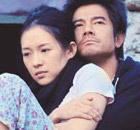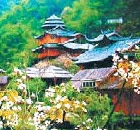Delicacies
Royal Tokaji, a sweet treat fit for a king
By Ye Jun (China Daily)
Updated: 2011-05-09 12:41
 |
Large Medium Small |

Hugh Johnson's affair with Royal Tokaji began about 40 years ago.
Johnson, then a British journalist, went to Hungary to attend a media tasting of Royal Tokaji. Served this "unbelievable white wine" in an underground cellar, he found it "sensuous" and "highly desirable".
But when he asked to buy it, he was told the wine was no longer made. The deep impression it made led him back to the region to set up the Royal Tokaji Wine Company Kft in 1990.
"It became my personal ambition to take part in the renaissance of this great wine," he says.
Johnson recently brought to Beijing four Royal Tokaji wines, the fruit of two decades of efforts.
Royal Tokaji Furmint dry white 2006 is fruity on the nose and fresh on the palate, with a lingering acidity at the tip of the tongue.
Royal Tokaji Late Harvest 2008 is nicely sweet, its acidity preventing the sweetness from becoming too much.
Royal Tokaji Aszu 5 Puttonyos 2006 smells and tastes of honey and dried apricot, as its intoxicating fragrance rises to the nose.
Royal Tokaji Mezes Maly 6 Puttonyos 1999 also has the taste of honey and dried apricot, but features more gravity and a long aftertaste.
The area in Hungary that produces Tokaji has a similar latitude as the northern part of France, with extremely cold winters and hot summers. The grape picking usually starts in late October, making it the latest in Europe.
Back in the 16th century, people found that rotting grapes can produce great sweet wines, because noble rot can dehydrate the grape, while preserving its essence. The making of Tokaji sweet wines involves two phases: the making of a white wine and then putting raisins with noble rot in it.
The mixing of raisins reduces the alcohol. But then a second fermentation starts to raise the alcohol level again. When alcohol reaches a certain density, yeast stops working. Therefore, a lot of sugar remains in the wine - as much as 200 grams in a liter, according to Johnson.
Johnson recommends using Royal Tokaji itself as a dessert after dinner. He also thinks it is a wonderful "television wine" to consume while watching TV.
"Tokaji plays the role after dinner that champagne plays before it. It produces sensations of luxurious well-being," the British writer says.
Royal Tokaji wines are available at the Wine Gallery in Beijing.









